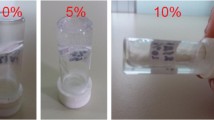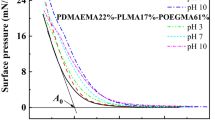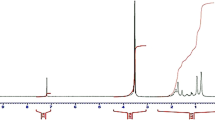Abstract
Isothermal-isobaric molecular dynamics simulation was used to study the diffusion mechanism of water in polyurethane-block-poly(N-isopropyl acrylamide) (PU-block-PNIPAm) with a hydrophobic PU/hydrophilic PNIPAm mass ratio of 1.4 to 1 at 298 K and 450 K. Here, the experimental glass transition temperature (T g ) of PU is 243 K while that of PNIPAm is 383 K. Different amounts of water up to 15 wt-% were added to PU-block-PNIPAm. We were able to reproduce the specific volumes and glass transition temperatures (250 K and 390 K) of PU-block-PNIPAm. The computed self-diffusion coefficient of water increased exponentially with increasing water concentration at both temperatures (i.e., following the free volume model of Fujita). It suggested that water diffusion in PU-block-PNIPAm depends only on its fractional free volume despite the free volume inhomogeneity. It is noted that at 298 K, PU is rubbery while PNIPAm is glassy. Regardless of temperature, radial distribution functions showed that water formed clusters with sizes in the range of 0.2–0.4 nm in PU-block-PNIPAm. At low water concentrations, more clusters were found in the PU domain but at high water concentrations, more in the PNIPAm domain. It is believed that water molecules diffuse as clusters rather than as individual molecules.

Similar content being viewed by others
References
Mathews A S, Narine S. Poly[N-isopropyl acrylamide]-co-polyurethane copolymers for controlled release of urea. Journal of Polymer Science. Part A, Polymer Chemistry, 2010, 48(15): 3236–3243
Seo Y, Brown J R, Hall L M. Effect of tapering on morphology and interfacial behavior of diblock copolymers from molecular dynamics simulations. Macromolecules, 2015, 48(14): 4974–4982
Srinivas G, Discher D E, Klein ML. Self-assembly and properties of diblock copolymers by coarse-grain molecular dynamics. Nature Materials, 2004, 3(9): 638–644
Fujita H, Kishimoto A, Matsumoto K. Concentration and temperature dependence of diffusion coefficients for systems polymethyl acrylate and n-alkyl acetates. Transactions of the Faraday Society, 1960, 56: 424–437
Fujita H. Free-volume model of diffusion in polymer solutions. Advances in Polymer Science, 1961, 3: 1–47
Fujita H. Notes on free volume theories. Polymer Journal, 1991, 23(12): 1499–1506
Fujita H. Comments on free volume theories for plymer-solvent systems. Chemical Engineering Science, 1993, 48(17): 3037–3042
Williams M L, Landel R F, Ferry J D. The temperature dependence of relaxation mechanisms in amorphous polymers and other glassforming liquids. Journal of the American Chemical Society, 1955, 77(14): 3701–3707
Hess B, Kutzner C, Van der Spoel D, Lindahl E. GROMACS 4: Algorithms for highly efficient, load-balanced, and scalable molecular simulation. Journal of Chemical Theory and Computation, 2008, 4(3): 435–447
Van der Spoel D, Lindahl E, Hess B, Groenhof G, Mark A E, Berendsen H J C. GROMACS: Fast, flexible, and free. Journal of Computational Chemistry, 2005, 26(16): 1701–1718
Lindahl E, Hess B, Van der Spoel D. GROMACS 3.0: A package for molecular simulation and trajectory analysis. Journal of Molecular Modeling, 2001, 7(8): 306–317
Berendsen H J, Van der Spoel D, van Drunen R. GROMACS: A message-passing parallel molecular dynamics implementation. Computer Physics Communications, 1995, 91(1–3): 43–56
Ostenbrink C, Villa A, Mark A E, van Gunsteren W F. A biomolecular force field based on the free enthalpy of hydration and solvation: The GROMOS force-field parameter sets 53A5 and 53A6. Journal of Computational Chemistry, 2004, 25(13): 1656–1676
Daura X, Mark A E, van Gunsteren W F. Parametrization of aliphatic CHn united atoms of GROMOS96 force field. Journal of Computational Chemistry, 1998, 19(5): 535–547
Berendsen H J, Postma J P, van Gunsteren W F, Hermans J. Interaction models for water in relation to protein hydration. Intermolecular Forces, 1981, 331–342
Theodorou D N, Suter U W. Detailed molecular structure of a vinyl polymer glass. Macromolecules, 1985, 18(7): 1467–1478
Hoover W G. Canonical dynamics: Equilibrium phase-space distributions. Physical Review A., 1985, 31(3): 1695–1697
Parrinello M, Rahman A. Polymorphic transitions in single crystals: A new molecular dynamics method. Journal of Applied Physics, 1981, 52(12): 7182–7190
Zhang Q G, Liu Q L, Chen Y, Wu J Y, Zhu A M. Microstructure dependent diffusion of water-ethanol in swollen poly (vinyl alcohol): A molecular dynamics simulation study. Chemical Engineering Science, 2009, 64(2): 334–340
Bondi A. van der Waals volumes and radii. Journal of Physical Chemistry, 1964, 68(3): 441–451
Raghu A V, Gadaginamath G S, Jawalkar S S, Halligudi S B, Aminabhavi T M. Synthesis, characterization, and molecular modeling studies of novel polyurethanes based on 2,2'-[ethane-1,2-diylbis (nitrilomethylylidene)] diphenol and 2,2'-[hexane-1,6-diylbis (nitrilomethylylidene)] diphenol hard segments. Journal of Polymer Science. Part A, Polymer Chemistry, 2006, 44(20): 6032–6046
Zhou D, Bayati F, Choi P. On the weak dependence of water diffusivity on the degree of hydrophobicity of acetylated hydroxypropyl xylan. Carbohydrate Polymers, 2013, 98(1): 644–649
Schild H G. Poly(N-isopropylacrylamide): Experiment, theory and application. Progress in Polymer Science, 1992, 17(2): 163–249
Harmandaris V, Mavrantzas V, Theodorou D, Kröger M, Ramírez J, Öttinger H C, Vlassopoulos D. Crossover from the rouse to the entangled polymer melt regime: Signals from long, detailed atomistic molecular dynamics simulations, supported by rheological experiments. Macromolecules, 2003, 36(4): 1376–1387
Cohen M H, Turnbull D. Molecular transport in liquids and glasses. Journal of Chemical Physics, 1959, 31(5): 1164–1169
Sreenivasan K. Diffusion of water and alcohol in chemically modified polyurethane. Polymer International, 1993, 30(3): 363–365
Pulat M, Akdogan A. The diffusion and bulk properties of polyurethane (PU)-based hydrophilic and hydrophobic membranes. Journal of Applied Polymer Science, 2002, 85: 193–198
McNeill M E, Graham N B. Properties controlling the diffusion and release of water-soluble solutes from poly(ethylene oxide) hydrogels 1. Polymer composition. Journal of Biomaterials Science. Polymer Edition, 1993, 4(3): 305–322
Costa L, Storti G. Self-diffusion of small molecules into rubbery polymers: A lattice free-volume theory. Journal of Polymer Science. Part B, Polymer Physics, 2010, 48(5): 529–540
Scholfield M R, Ford M C, Van der Zanden C M, Billman M M, Ho P S, Rappé A K. Force field model of periodic trends in biomolecular halogen bonds. Journal of Physical Chemistry B, 2015, 119(29): 9140–9149
Tamai Y, Tanaka H, Nakanishi K. Molecular dynamics study of water in hydrogels. Molecular Simulation, 1996, 16(4–6): 359–374
Acknowledgements
The authors would like to thank WestGrid and Compute/Calcul Canada for providing the computational facility and support for this research. Funding from Agriculture Funding Consortium was greatly appreciated.
Author information
Authors and Affiliations
Corresponding author
Rights and permissions
About this article
Cite this article
Zhou, Y., Choi, P. Molecular dynamics study of water diffusion in an amphiphilic block copolymer with large difference in the blocks’ glass transition temperatures. Front. Chem. Sci. Eng. 11, 440–447 (2017). https://doi.org/10.1007/s11705-017-1626-2
Received:
Accepted:
Published:
Issue Date:
DOI: https://doi.org/10.1007/s11705-017-1626-2




